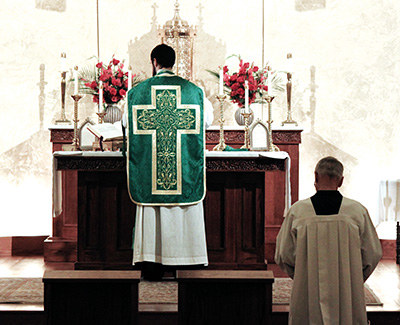
One of the most visual differences in Mass in the Extraordinary Form is that the priest celebrates with his back to the people. (Photo by Gene Buglewicz)
By Gene Buglewicz
OXFORD – Father Scott Thomas celebrated Mass in the Extraordinary Form at St. John the Evangelist Catholic Church in Oxford in November. The Mass wasn’t “extraordinary” as we usually define it, but the Mass was the Extraordinary Form, commonly known as the Latin Mass.
The Latin Mass as many Catholics know it came from Pope Pius V, who mandated a single form of the Mass at the Council of Trent (1545 – 1563). The Second Vatican Council (1962 – 1965) instituted a new, simplified liturgy that also substituted Latin for common language as well as restored a few elements which had been lost over time. In 2007, Pope Benedict XVI announced that the Extraordinary Form of the Mass could be practiced by individual parishes without permission, in part to better connect Catholics to the historical traditions of the church.
What are the differences a modern Catholic would see in the Mass in the Extraordinary form? As a bell rings, the priest enters the sacristy from the side of the altar and stands with his back to the congregation. The priest prays the Mass in Latin with English spoken only during the homily when the priest faces the congregation and addresses them.
Communion is taken at a communion rail which separates the altar from the congregation or at a kneeling bench in front of the priest. Rather than receiving the sacred Host in the hand, which is common today, the Host is taken directly on the tongue.
Worshiping at the Extraordinary Form of the Mass was offered as a special event for the University of Mississippi Catholic Campus Ministry students at St. John the Evangelist. Approximately 40 students made up the 125 parishioners and visitors who attended the Latin Mass.
Father Thomas, pastor of Clarksdale St. Elizabeth Parish, travels throughout the Diocese of Jackson celebrating the Extraordinary Form of the Mass for parishes who request it.
